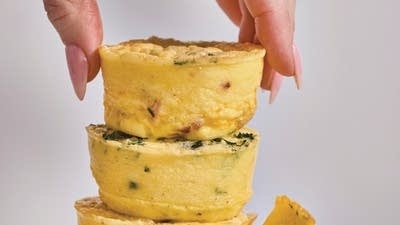
Have you heard of halva? It's sometimes called sesame candy; you find bars of it in Middle Eastern or South Asian stores. But fans of halva say it's best enjoyed fresh, sliced off a wheel at a deli. Lisa Mendelson is the co-founder of Seed + Mill in New York City. Her shop specializes in a wide range of traditional and eclectic halva, as well as other sesame-based desserts. She spoke with our contributor, The New York Times food writer Melissa Clark, about halva and how she uses it to create unique treats. If you want to try your hand at making halva at home, check out Melissa Clark’s halva article and recipe from The New York Times.
Melissa Clark: Lisa, what is halva?
Lisa Mendelson: Halva is a delicious, indulging, “better for you” treat. It’s made from tahini, sugar, vanilla, and many different toppings. A lot of people aren’t familiar with what halva is, but once you try it, you'll agree it has a unique flavor. Halva is mainly found in the Middle East, but it’s becoming more common in the US and in Europe. And it’s usually vegan and gluten-free.
 Lisa Mendelson
Photo: Christaina Nuzzo
Lisa Mendelson
Photo: Christaina Nuzzo
MC: In the Middle East, how is it usually eaten? Is it just a dessert or do they use it in cooking?
LM: I grew up in Israel. And for me, halva was something I ate on a weekly basis. I would wake up in the morning, have some toast, and crumble halva over my toast, which is so delicious. I will eat it as-is. I think it’s a beautiful treat. It’s also a better choice if you’re looking for something sweet with some sort of health nutrition benefits to it. I also bake with halva.
MC: Is it traditional to bake with halva? Or is that something that you and other pastry chefs have started to do recently?
LM: I think it’s becoming more common today; it was less common in the past. Growing up in Israel, I never baked with halva. But, in the past few years, you’re seeing chefs like Yotam Ottolenghi, he’s the one that basically brought Israeli food to the map. He’s got so many recipes that have halva as an ingredient.
MC: Why can’t you make halva at home? I have tried and I can never get it quite as delicious as the store-bought.
LM: The list of ingredients of halva is pretty simple: tahini, sugar, and whatever topping you would like to add. But actually getting the amazing texture is difficult, and it takes a lot of practice to get that flakiness of the halva. Getting the right temperature. When to add the tahini. It’s a fine art.
 Seed + Mill has a variety of more than 30 flavors of halva. Left: halva cakes - Rose Oil, Pistachio, Coffee, Cinnamon, and Sea Salt Dark Chocolate | Left: wedges of 70% Dark Chocolate vegan + gluten free halva.
Photo: Erez Ben Shachar
Seed + Mill has a variety of more than 30 flavors of halva. Left: halva cakes - Rose Oil, Pistachio, Coffee, Cinnamon, and Sea Salt Dark Chocolate | Left: wedges of 70% Dark Chocolate vegan + gluten free halva.
Photo: Erez Ben Shachar
MC: You have a roster of unusual flavors. You have the traditional vanilla, pistachio almond, and the chocolate. But you also have dulce de leche, and you have chile. How did you develop your flavors?
LM: It’s interesting, what’s fun about working with halva is that it has a neutral flavor. It tastes a bit nutty. Some people compare it to the inside of a Butterfinger chocolate.
MC: Yes. I think that’s a good comparison.
LM: What’s fun is that you can be creative with halva. You can add so many different flavors. The dominant neutral flavor stays, but you’ve got the adding of the chia seeds or the rose oil, which gives it a unique flavor.
MC: If you want to buy it, you buy a chunk of it usually. You buy like a slice. What should you do when you get it home? How do you store halva?
LM: Because halva is clean and has no hydrogenated oils or preservatives, it’s very important that it is refrigerated. Not because it’s bad to eat, but it starts losing its firmness and you can see some oil separating if it’s not put in a very cool area. We recommend to keep it refrigerated.
MC: Seed + Mill is your brand. Are there other brands on the market that you could recommend if people can’t get yours?
LM: It’s definitely not easy to find good quality halva out there. I would try and find halva that are freshly cut in delis as opposed to packed, because you do have bars that are packed. Usually the chance of getting a high quality halva is higher at a deli where they cut it fresh for you.
MC: Look for a Middle Eastern deli that’s cutting it fresh.
LM: Exactly.
Before you go...
Each week, The Splendid Table brings you stories that expand your world view, inspire you to try something new, and show how food connects us all. We rely on your generous support. For as little as $5 a month, you can have a lasting impact on The Splendid Table. And, when you donate, you’ll join a community of like-minded individuals who love good food, good conversation, and kitchen companionship. Show your love for The Splendid Table with a gift today.
Thank you for your support.
Donate today for as little as $5.00 a month. Your gift only takes a few minutes and has a lasting impact on The Splendid Table and you'll be welcomed into The Splendid Table Co-op.




